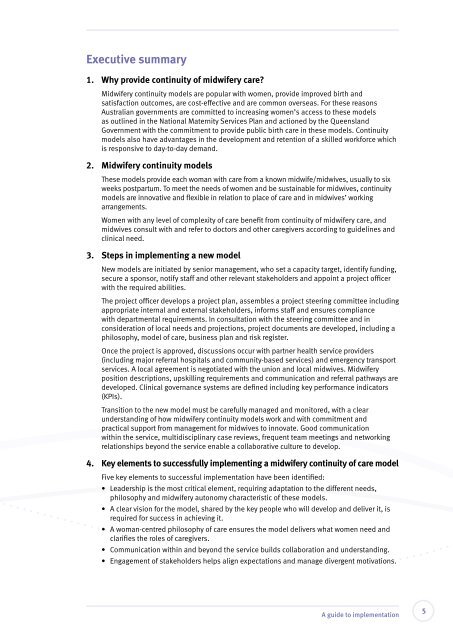Delivering continuity of midwifery care to Queensland women
Delivering continuity of midwifery care to Queensland women
Delivering continuity of midwifery care to Queensland women
You also want an ePaper? Increase the reach of your titles
YUMPU automatically turns print PDFs into web optimized ePapers that Google loves.
Executive summary<br />
1. Why provide <strong>continuity</strong> <strong>of</strong> <strong>midwifery</strong> <strong>care</strong><br />
Midwifery <strong>continuity</strong> models are popular with <strong>women</strong>, provide improved birth and<br />
satisfaction outcomes, are cost-effective and are common overseas. For these reasons<br />
Australian governments are committed <strong>to</strong> increasing <strong>women</strong>’s access <strong>to</strong> these models<br />
as outlined in the National Maternity Services Plan and actioned by the <strong>Queensland</strong><br />
Government with the commitment <strong>to</strong> provide public birth <strong>care</strong> in these models. Continuity<br />
models also have advantages in the development and retention <strong>of</strong> a skilled workforce which<br />
is responsive <strong>to</strong> day-<strong>to</strong>-day demand.<br />
2. Midwifery <strong>continuity</strong> models<br />
These models provide each woman with <strong>care</strong> from a known midwife/midwives, usually <strong>to</strong> six<br />
weeks postpartum. To meet the needs <strong>of</strong> <strong>women</strong> and be sustainable for midwives, <strong>continuity</strong><br />
models are innovative and flexible in relation <strong>to</strong> place <strong>of</strong> <strong>care</strong> and in midwives’ working<br />
arrangements.<br />
Women with any level <strong>of</strong> complexity <strong>of</strong> <strong>care</strong> benefit from <strong>continuity</strong> <strong>of</strong> <strong>midwifery</strong> <strong>care</strong>, and<br />
midwives consult with and refer <strong>to</strong> doc<strong>to</strong>rs and other <strong>care</strong>givers according <strong>to</strong> guidelines and<br />
clinical need.<br />
3. Steps in implementing a new model<br />
New models are initiated by senior management, who set a capacity target, identify funding,<br />
secure a sponsor, notify staff and other relevant stakeholders and appoint a project <strong>of</strong>ficer<br />
with the required abilities.<br />
The project <strong>of</strong>ficer develops a project plan, assembles a project steering committee including<br />
appropriate internal and external stakeholders, informs staff and ensures compliance<br />
with departmental requirements. In consultation with the steering committee and in<br />
consideration <strong>of</strong> local needs and projections, project documents are developed, including a<br />
philosophy, model <strong>of</strong> <strong>care</strong>, business plan and risk register.<br />
Once the project is approved, discussions occur with partner health service providers<br />
(including major referral hospitals and community-based services) and emergency transport<br />
services. A local agreement is negotiated with the union and local midwives. Midwifery<br />
position descriptions, upskilling requirements and communication and referral pathways are<br />
developed. Clinical governance systems are defined including key performance indica<strong>to</strong>rs<br />
(KPIs).<br />
Transition <strong>to</strong> the new model must be <strong>care</strong>fully managed and moni<strong>to</strong>red, with a clear<br />
understanding <strong>of</strong> how <strong>midwifery</strong> <strong>continuity</strong> models work and with commitment and<br />
practical support from management for midwives <strong>to</strong> innovate. Good communication<br />
within the service, multidisciplinary case reviews, frequent team meetings and networking<br />
relationships beyond the service enable a collaborative culture <strong>to</strong> develop.<br />
4. Key elements <strong>to</strong> successfully implementing a <strong>midwifery</strong> <strong>continuity</strong> <strong>of</strong> <strong>care</strong> model<br />
Five key elements <strong>to</strong> successful implementation have been identified:<br />
• Leadership is the most critical element, requiring adaptation <strong>to</strong> the different needs,<br />
philosophy and <strong>midwifery</strong> au<strong>to</strong>nomy characteristic <strong>of</strong> these models.<br />
• A clear vision for the model, shared by the key people who will develop and deliver it, is<br />
required for success in achieving it.<br />
• A woman-centred philosophy <strong>of</strong> <strong>care</strong> ensures the model delivers what <strong>women</strong> need and<br />
clarifies the roles <strong>of</strong> <strong>care</strong>givers.<br />
• Communication within and beyond the service builds collaboration and understanding.<br />
• Engagement <strong>of</strong> stakeholders helps align expectations and manage divergent motivations.<br />
A guide <strong>to</strong> implementation<br />
5
















